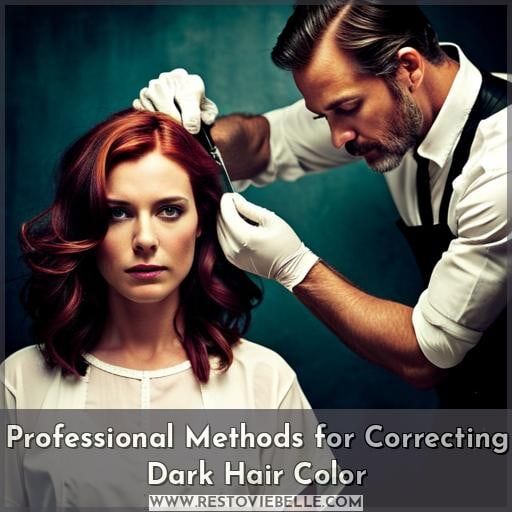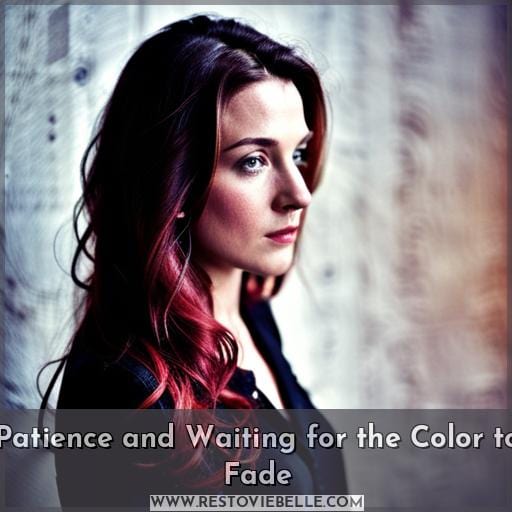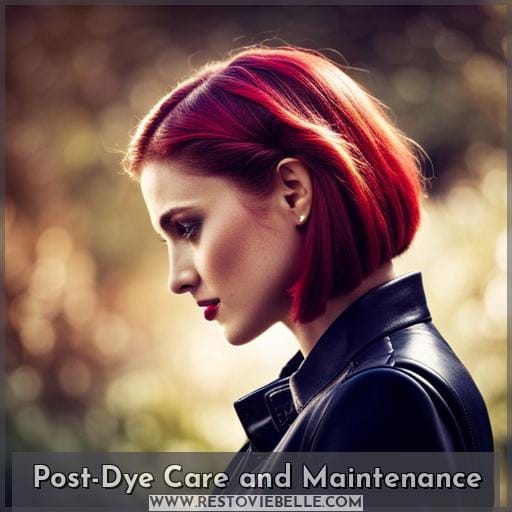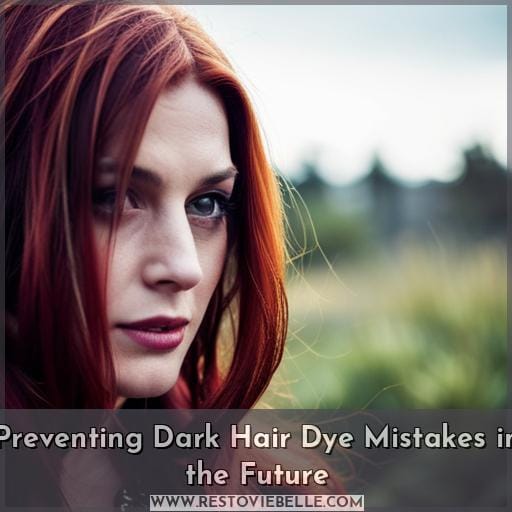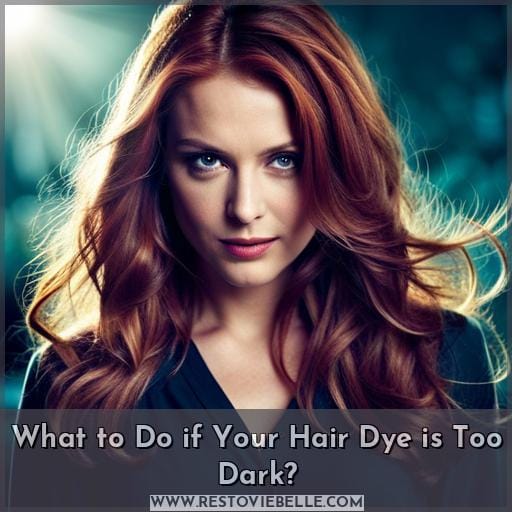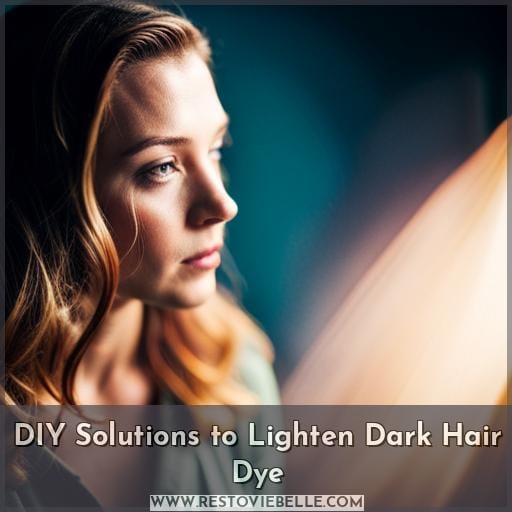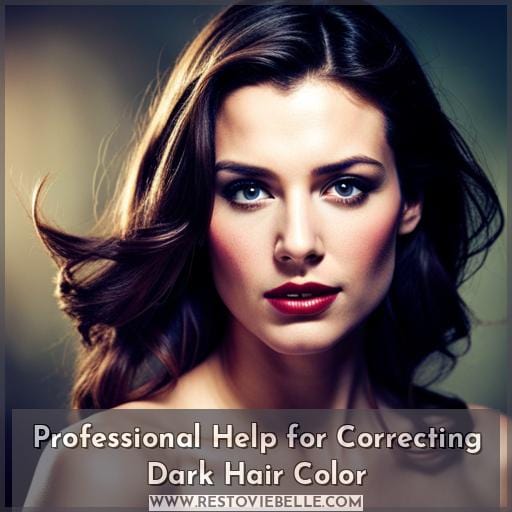This site is supported by our readers. We may earn a commission, at no cost to you, if you purchase through links.
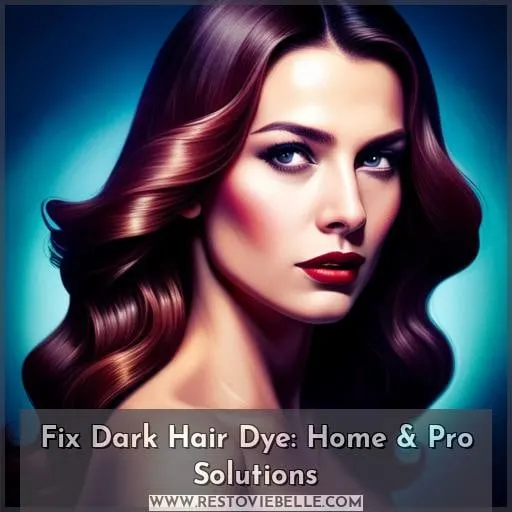 Do you ever wish your hair color was just a bit lighter? If so, you’re certainly not alone. Unfortunately, sometimes the dye job doesn’t turn out quite like we’d hoped and our hair ends up too dark! But don’t worry – there are plenty of ways to fix this problem.
Do you ever wish your hair color was just a bit lighter? If so, you’re certainly not alone. Unfortunately, sometimes the dye job doesn’t turn out quite like we’d hoped and our hair ends up too dark! But don’t worry – there are plenty of ways to fix this problem.
In this article, we’ll discuss how to lighten dark hair dye at home as well as professional methods for correcting overly-dark colors.
Read on to learn all about fixing that pesky darker than intended color from your last DIY or salon visit.
Table Of Contents
- Key Takeaways
- How to Lighten Dark Hair Dye at Home
- Professional Methods for Correcting Dark Hair Color
- Patience and Waiting for the Color to Fade
- Post-Dye Care and Maintenance
- Preventing Dark Hair Dye Mistakes in the Future
- What to Do if Your Hair Dye is Too Dark?
- DIY Solutions to Lighten Dark Hair Dye
- Professional Help for Correcting Dark Hair Color
- Conclusion
Key Takeaways
- Use a paste of baking soda and lemon juice for gradual lightening.
- Try an apple cider vinegar rinse to balance pH and maintain color.
- Crush vitamin C tablets with shampoo for color correction.
- Consider using clarifying shampoo or purple/blue shampoo to remove excess pigment or neutralize brassy tones.
How to Lighten Dark Hair Dye at Home
If your hair dye has come out too dark, you may be looking for ways to lighten it. Baking soda and lemon juice paste is one of the most popular DIY approaches that can help break down the molecules in dyed hair, allowing for a lighter color result.
With regular application of this paste over time, you can achieve more manageable and natural-looking locks without having to resort to professional treatments or harsh chemicals.
Baking Soda and Lemon Juice Paste
You deserve beauty and confidence in your hair color, so if it’s too dark, try a baking soda and lemon juice paste.
Apple Cider Vinegar Rinse
A gentle solution to lighten your dark hair dye is an apple cider vinegar rinse. Rich in nutrients and natural acids, ACV helps restore pH balance while cleansing the scalp of buildup from styling products, dyes, and other environmental factors.
This DIY application can be used as part of a color correction technique or simply for regular natural hair care maintenance! With the benefits it offers to both coloring and conditioning treatments, ACV is a must-have ingredient for those looking to tackle their post-dye hair treatments safely at home.
Vitamin C Tablets and Shampoo
Mixing crushed Vitamin C tablets with shampoo can help lighten your locks and neutralize brassy tones. DIY remedies such as this offer an effective, cost-friendly way to achieve color correction. Color-safe products, combined with post-dye care, will maintain hair health for long-lasting results.
Clarifying Shampoo
Transform your mane and watch the dark dye disappear with a clarifying shampoo! Clarifying shampoos help to protect against color buildup, remove excess pigment, and prevent hair from becoming too dark.
A strand test is highly recommended before any DIY lightening attempts. Use it as part of an overall post-dye treatment for maximum benefits, such as preventing oxidation or fading colors.
Purple or Blue Shampoo
Try using a purple or blue shampoo to neutralize brassy tones in your hair for an even color. Benefits include helping to maintain colored hair, preventing brassiness, and restoring vibrancy. When choosing toning products, consider the intensity of the desired result and pick either purple or blue based on the current shade.
Professional Methods for Correcting Dark Hair Color
Are you dealing with hair dye that turned out too dark? It can be challenging to lighten it, but there are professional methods available. Bleed the color using clarifying shampoo, use hair lighteners or toners for a lighter shade, apply color remover to shrink and rinse away dye molecules, and seek professional help if DIY attempts fail.
Bleeding the Color
Unleash your inner blonde by fading the color with a powerful clarifying shampoo. Dye fading is essential for hair health, so strand test before coloring and use moisturizing masks regularly to prevent brassiness.
Rinse away excess dye molecules with a gentle color remover or wait until it naturally fades.
Hair Lighteners or Toners
Unlock the power of hair lighteners or toners to achieve a lighter shade and restore your original color. Hair toners can prevent brassiness, maintain hair dye, correct DIY lightening mistakes, and help with color fading.
Opt for formulas enriched with grape seed oil that won’t strip natural oils from your locks.
Color Remover
Jumpstart your journey to a brighter shade with color remover and watch as unwanted hues fade away. It’s an effective way to lighten dark hair dye without damaging your locks. Color removers are gentle enough for all hair types, ensuring a quick and efficient fading process.
Follow up with nourishing conditioners or masks for healthy tresses that look amazing! Keep in mind that there are risks associated with any type of dyeing, so it’s important to be aware before you begin the coloring process.
Seeking Professional Help
If DIY attempts fail, seeking professional help is the best option to ensure your hair color looks exactly as you want. Consult a knowledgeable and experienced colorist for expert advice on how to lighten dark dyed hair.
Opt for professional consultations or salon assistance with specialized services like color correction and dye removal. Experienced stylists can provide safe and effective treatments such as deep conditioning, hydrating masks, oils, post-dye care maintenance products, or even professional hair lightening that will restore healthiness back into your locks.
Patience and Waiting for the Color to Fade
Waiting for the color to fade may be your best option if you’ve dyed your hair too dark, so have patience and take care of your locks until it fades naturally. This strategy can give you a better outcome than rushing to fix it with additional products or treatments.
It’s important to understand that there is no one-size-fits-all timeline when waiting for dye results, as some colors will fade faster than others depending on the product used and individual hair type.
Patience in this case can provide many benefits such as preventing damage from harsher treatment solutions like bleaching or using toners.
Additionally, allowing time for the new shade of dye to blend into existing natural tones might produce more subtle results which could make all the difference between an unnatural look and a stylish hue.
So don’t panic if things didn’t turn out quite right during coloring; instead show some patience while enjoying healthier looking strands that come along with taking care of them daily throughout this process!
Post-Dye Care and Maintenance
To maintain the best appearance of your dark hair color, you will need to invest in deep conditioning treatments and hydrating masks. Additionally, using a color-safe shampoo will help preserve the dye and prevent further fading.
Deep Conditioning and Hydrating Masks
Nourish your mane with deep conditioning and hydrating masks to restore its health after lightening dark dyed hair. These treatments can help stimulate growth, lock in moisture, repair damage, and boost shine.
Hair mask benefits include hydration, strength, smoothness, and protection from heat styling tools.
Regular use of deep conditioners encourages healthy hair growth while hydrating techniques promote long-lasting locks with a brilliant luster.
Utilize regular deep conditioning and hydrating masks to maintain optimum color vibrancy when correcting dark dye jobs – you’ll be glad you did!
Color-Safe Shampoo
Give your hair the nourishment it deserves with a color-safe shampoo that will protect and preserve its vibrancy. A quality color-safe shampoo can help maintain hair dye, prevent fading, and provide toning options to keep locks looking fresh.
Stop worrying about dark dyed hair by using vitamin C for lightening or other specialty products like clarifying shampoos and masks.
Avoiding Heat Styling Tools
To keep your hair looking vibrant and healthy, avoid using heat styling tools as much as possible—it’ll be like a miracle in disguise! Instead, opt for creative heatless styling alternatives such as air drying with twists, braids, buns, or scrunching.
Prolong the life of your color-treated hair by allowing its natural texture to shine through while protecting it from unnecessary damage.
- Heat-Free Styling Alternatives
- Hair Health Protection
- Damage Prevention
- Natural Texture Showcase
- Innovative Techniques
Preventing Dark Hair Dye Mistakes in the Future
To prevent the unfortunate result of dark hair dye, it is essential to perform a strand test before coloring. This helps assess if you are achieving your desired color and can alert you to any potential problems beforehand so that adjustments can be made accordingly.
It also allows for an opportunity to determine how long the process should take and whether or not more than one application may be necessary.
Strand Testing Before Coloring
Before attempting to color your hair, it’s important to do a strand test. Oxidation and daily washing can lighten the color after application, so assessing the outcome is key in avoiding unwanted results.
Color correction methods such as a baking soda/lemon juice paste or apple cider vinegar can help reverse mistakes while maintaining hair health. DIY approaches like clarifying shampoo and bleach baths are also great options for lightening dark dyed hair.
Starting at Mid-Lengths and Ends
When coloring your hair, start at the mid-lengths and ends to help prevent it from becoming too dark. Respect the recommended setting time and avoid using darker colors than your eyebrows. It is also helpful to stay within two tones of your natural color to avoid a dye disaster.
For future prevention, you can choose formulas enriched with grape seed oil or use lightening products like shampoos or toners for color correction if needed.
To maintain an optimal shade after recoloring, wait at least one month before reapplying any new formula.
Assessing Hair Health and Color Goals
Evaluate your hair health and desired color goals to ensure a successful dye job in the future. Analyze fading, assess risks of damage from lightening or darkening processes, and perform strand testing to prevent hair mistakes.
Consult natural lightening methods for gradual color transformation instead of abrupt changes.
What to Do if Your Hair Dye is Too Dark?
If your hair color is too dark, there are a variety of solutions to help lighten it and restore balance. You can try DIY remedies such as a baking soda and lemon juice paste, apple cider vinegar, crushed vitamin C tablets mixed with shampoo, or clarifying shampoo.
Another option is to use purple or blue shampoos to neutralize brassy tones or even try a bleach bath for more diluted lightening effects.
If you prefer professional assistance, you can use hair lighteners/toners and color removers, which can shrink away dye molecules from the hair shafts. After dyeing your hair, it’s important to take care of it by using deep conditioning treatments with hydrating masks and oils to nourish dry hair.
Additionally, using color-safe shampoos can help protect against fading colors over time.
To prevent this issue from happening again, be careful when selecting shades that match your natural complexion for the mid-length and ends of your hair. Also, avoid layering darker than intended hues in future applications altogether.
DIY Solutions to Lighten Dark Hair Dye
You’ll be amazed at how quickly and easily you can lighten your dark dyed hair with these DIY solutions! Start by mixing a paste of baking soda and lemon juice.
Another option is to use Apple Cider Vinegar, which can gently strip away excess dye. If that’s not enough, you can try crushing Vitamin C tablets and mixing them with shampoo.
Clarifying shampoo is also a good choice for removing buildup and unwanted color. If you’re dealing with brassy tones, purple or blue shampoos are perfect for neutralizing them.
If you’re looking for a gentler option that doesn’t require harsh chemicals, you can try bleach baths. These are more diluted options specifically designed for lightening hair without causing any damage.
With these natural ingredients and at-home remedies, you won’t need expensive salon treatments anymore!
Professional Help for Correcting Dark Hair Color
If your DIY efforts to lighten dark dyed hair haven’t been successful, consider seeking professional help for correcting the color. Hair color professionals have access to tools and techniques that can address even the most complex of dyeing dilemmas.
An experienced professional could be consulted in order to develop a personalized solution that will produce desired results with minimal risk or damage.
A consultation at a salon offers an ideal opportunity for you to discuss your unique situation and goals with a trained expert in color correction who can provide tailored advice on how best to go about achieving them.
The experts may also suggest visiting multiple salons before settling on one as it is important that you feel comfortable communicating openly without fear of judgment or criticism from stylists who are unfamiliar with proper coloring technique and application methods.
Professional salon services such as custom highlights, lowlights, foiling, and balayage artistry often require special equipment like lasers used by professionals only, which cannot be accessed through retail products.
But through these consultations at various salons, one might find out their options regarding hair lightening solutions by experts more clearly.
Follow-up post-dye treatments such as deep conditioning masks, nourishing oils, etc., should also be kept in mind after receiving this kind of assistance from professionals so as not to cause any further damage due to excessive heat styling tools or daily shampooing, which could affect long-term achievements achieved through these particular processes.
Conclusion
It’s hard to feel confident when you’ve gone too dark with your hair dye. One of the worst mistakes you can make is trying to fix it yourself without understanding the risks.
Jack, for instance, tried to lighten his dark hair dye with baking soda and lemon juice but ended up with orange streaks. Don’t let this happen to you. To avoid disaster, consult a professional stylist, use color-safe products, and never skip the strand test.
If you do end up with hair dye that’s too dark, try a deep conditioning treatment, a clarifying shampoo, or a toner. With patience, you can get back to your desired look. Just remember to be mindful of your hair health and take your time when selecting the right products for your desired color.

